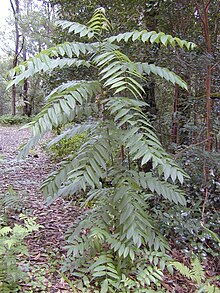Australian Red Cedar
| Toona ciliata | |
|---|---|
 |
|
| Small specimen of Toona ciliata | |
| Scientific classification | |
| Kingdom: | Plantae |
| (unranked): | Angiosperms |
| (unranked): | Eudicots |
| (unranked): | Rosids |
| Order: | Sapindales |
| Family: | Meliaceae |
| Genus: | Toona |
| Species: | T. ciliata |
| Binomial name | |
|
Toona ciliata M. Roem. |
|
| Synonyms | |
|
|
Toona ciliata is a forest tree in the mahogany family which grows throughout southern Asia from Afghanistan to Papua New Guinea and Australia. It is commonly known as the red cedar (a name shared by other trees), toon or toona (also applied to other members of the genus Toona), Australian redcedar,Burma cedar, Indian cedar, Moulmein cedar or the Queensland red cedar. It is also known as Indian mahogany.
In Australia its natural habitat is now extensively cleared subtropical rainforests of New South Wales and Queensland. The Australian population was formerly treated as distinct species under the name Toona australis. The species can grow to around 60 m (200 ft) in height and its trunk can reach 3 m (10 ft) in girth. The largest recorded T. ciliata tree in Australia grew near Nulla Nulla Creek, west of Kempsey, New South Wales and was felled in 1883.
The southernmost limit of natural distribution is on basaltic soils, growing west of the Princes Highway near the village of Termeil, south of Ulladulla, southern Illawarra, NSW. It also naturally occurs at Norfolk Island.
It is one of Australia's few native deciduous trees. The timber is red in colour, easy to work and very highly valued. It was used extensively for furniture, wood panelling and construction, including shipbuilding, and was referred to as "red gold" by Australian settlers. Heavily and unsustainably exploited in the 19th Century and early 20th Century, almost all the large trees have been cut out and the species is essentially commercially extinct. Availability of this timber is now limited.
...
Wikipedia

